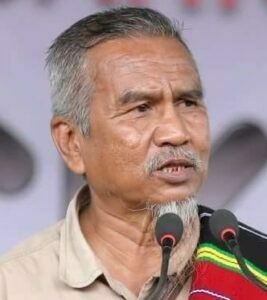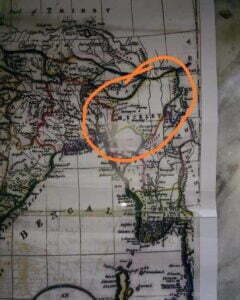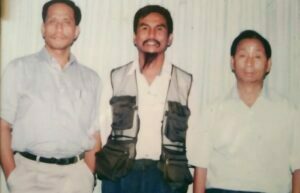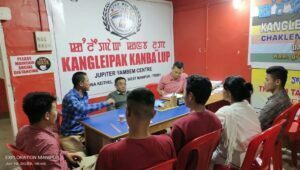Recently, a joint delegation of the United Naga Council of Manipur (UNC) and the Coordinating Committee on Manipur Integrity (COCOMI), which is the apex body of the valley-based Meitei led Civil Society Organizations, had called on Manipur Chief Minister N Biren Singh.

By Yambem Laba
Centuries before the Kukis made their presence felt in Manipur, the Meiteis had descended into the valley from atop the Koubru mountains in the north whilst the Nagas remained in the hills. But the links between the two were maintained down the years as the Meitei community’s main festival in the socialization process called Lai Haraoba or the “merry making of the gods” must have the appearance of a Tangkhul Naga chieftain on the last day. Kabui Naga dances also form an integral part of this festival which runs from three to seven days. Like-wise, the Liangmei Nagas also claim their origins from the Koubru Hills.
Like the Koubru, there are two other mountaintops which are considered sacred to the now almost majority Meitei population referred to as the valley settlers. They are the Thangjing in the south in Churachandpur district and the Nongmaijing in Kangpokpi district. They used to make annual pilgrimages to these peaks to pray to the sylvan deities. But in all three locations the local areas are dominated by members of the Kuki tribes. Trouble began about three years back when the Kukis renamed Thangjing Peak as “Tinthang” which drew the ire of the Meitei people. But the Kukis were adamant and remain so.

Trouble erupted last year when Kuki villagers residing around Koubru attempted to prevent Meitei pilgrims from approaching Koubru, vandalizing vehicles enroute. It raised a huge hue and cry across the state, and they eventually relented. Then many Civil Society Organisations began questioning the growth of Kuki villages around Koubru which on paper is a Reserved Forest area. It was also alleged that the Kuki village chieftains are engaged in planting poppy, from which opium is produced and is later turned into Brown Sugar or a crude form of Heroin No. 4 in the Muslim areas of Thoubal district in the valley. In fact, the Kuki population had almost tripled in the last 30 years and so also the number of Kuki villages.
The other flashpoint was almost reached when a group of the BJP’s Youth Wing attempted to plant trees in the Thangjing area. They were forcibly prevented by the village chief there who insisted that any movement in that area needed his prior permission, including Meitei pilgrims wishing to go atop and pray to Lord Thangjing.
Then came the reverse backlash from valley based CSOs who insisted that villagers residing in Henglep Sub-Division of Churachandpur District were henceforth barred from venturing down to the valley for purposes of trade and commerce. That was when the ban on movement towards Thangjing was lifted and the chief went on record stating that he would provide amenities to the pilgrims.
The last straw on the camel’s back was when last month a team went to plant trees around the Nongmaijing Hill area along with representatives of the Forest Department. There, they were turned on by hundreds of Kuki villagers who tore down the festoons and forcibly prevented the plantation drive. Eventually the police had to be called in. Later top forest officials clarified that the Kuki village located in the area had shifted base twice in the last 20 years and was now firmly entrenched in the Reserved Forest area.
In the meantime, NSCN Supremo Thieungaleng Muivah had announced from Camp Hebron near Dimapur in Nagaland that the only two indigenous people of Manipur are the Nagas and the Meities. This is important because he was implying that the Kukis are recent arrivals in Manipur. The Nagas and Meiteis were at loggerheads with each other since 2001 when the Meiteis erupted and burnt down the Assembly House and the Chief Ministerial Office protesting against the territorial extension of the “Indo-Naga Ceasefire” into Manipur. Eighteen people had died in the subsequent police firing. June 18 is annually observed as Unity Day in Manipur where thousands show up to pay floral tributes to the graves of the 18 brave hearts who died on that day.

The Naga backlash had included a record 120-day blockade on the National Highways during which prices of essential items had spiralled to dizzying heights. The blockade was imposed by the United Naga Council of Manipur said to be the over ground face of the NSCN (I-M) in Manipur then. But the Naga animosity towards the Meiteis seems to have waned following the anti-Meitei gestures of the Kukis. Muivah’s NSCN had in 1992-94 apparently masterminded the ethnic killing of the Kukis during which some 1,200 Kukis were killed, and hundreds of Kuki villages burnt. The Meitei had remained neutral during the clashes.
Recently a joint delegation of the United Naga Council of Manipur (UNC) and the Coordinating Committee on Manipur Integrity (COCOMI), which is the apex body of the valley-based Meitei led Civil Society Organizations, had called on Manipur Chief Minister N Biren Singh. This could have only been possible only if those who control these bodies had okayed the move. So much so that even as the talks between the Government of India and the NSCN (I-M) seem to have bogged down, it is believed that Muivah might be showing the olive branch to the UNLF, the oldest insurgent group operating in Manipur.
According to top sources, recently Anthony Shimray, chief of the “Naga Army” had embraced with a top Meitei “underground” leader and had exchanged scarves at Yaingnapokpi, bordering Imphal East and Ukhrul district. The group most likely is the UNLF, the group that had saved Muivah’s life in 1988 in the Somra Tract area of Myanmar when he was under attack by the followers of SS Khaplang. The UNLF remained with the Khaplang Group. The UNLF exchanged tirades with NSCN (I-M) accusing each other of the evils in the region. But that apart the new reported tie up of the NSCN (I-M) and the UNLF should suggest a spell of renewed and more potent insurgency in the region, the ongoing Naga peace talks notwithstanding.
Ethnically speaking, besides the original Naga tribes there are also a group of tribes known as the Old Kukis. There were the Anals, Lamkangs, Chothes and Koirengs. But now they have been classified as Nagas and form a substantial portion of the cadres of the NSCN. The new Kukis are recent imports. Manipur became a British protectorate in 1826 following the signing of the Treaty of Yandaboo and Britain began placing Political Agents in the State. The second Political Agent McCulloch devised a plan to plug the exposed frontier provinces by importing Kukis from the then Burma. They were of the Tadhou tribe who follows an absolute monarchical form of administration. In 1917, they rose against the British Colonial policy of Labour recruitment to aid the war effort in France as members of the Labour Corps.
The Kuki armed uprising in Manipur began in 1992-93 when the NSCN-backed Naga Lim Guards spearheaded the ethnic cleansing of the Kukis. This gave rise to the growth of the Kuki Defence Force. Later, the Kuki National Army whose aim was the creation of a Kuki State in Myanmar started opening bases in Manipur. Then came the Kuki National Front, fighting for a Kuki State within India carved out of Manipur. Then some 30 odd other Kuki armed groups sprung up with an array of demands. They are now under the Suspension of Operations with the State and Central Governments and these cadres were said to have been utilized by the BJP during the last elections.

In recent times, there are some serious accusations levelled by various Kuki groups relating to the history of Manipur. Apart from claiming to be children of the soil, they have said that the controversial Merger Agreement between Maharaj Bodh Chandra and the Government of India in Shillong in 1949 pertains to only the 700 square miles of the valley area. This had made them earn the wrath of titular king and Rajya Sabha MP Leishemba Sanajaouba.
In the meantime, the UNLF seems to have begun a recruiting drive after a long gap. On 24 June, the police apprehended the former President of the All Manipur Working Journalists Union (AMWJU) Bijoy Kakchingtabam and Leimapokpam Sanjitkumar, Standing Committee Member of the AMWJU from Bishenpur District where they had allegedly gone to recruit a boy for onward movement to Myanmar to join the UNLF Camp there for training. They have since been remanded to six days police custody. As the arrest involves a former President of the powerful AMWJU, it is believed that the nod of approval must have come from the Chief Minister himself who also holds the Home Portfolio. But in the shifting sands of Manipuri politics, the realignment of various ethnic groups in this trouble torn state seems to be on the cards.
(The writer is the Imphal-based Special Representative of The Statesman. This article was first published by The Statesman. The views and opinions expressed here are those of the author’s and do not necessarily reflect the views or positions of TFM).
